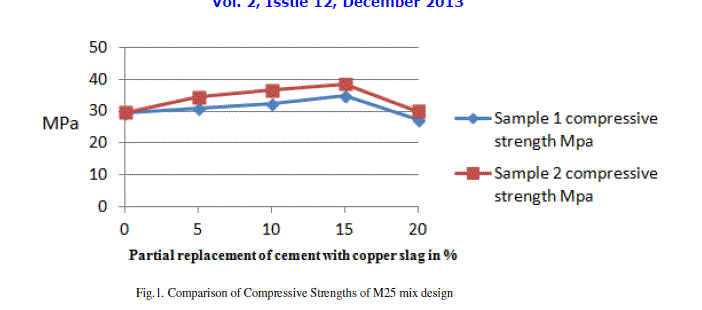ISSN ONLINE(2319-8753)PRINT(2347-6710)
ISSN ONLINE(2319-8753)PRINT(2347-6710)
Vamsi Pradeep I1, Suresh Reddy S2, Kishore Kumar M3
|
| Related article at Pubmed, Scholar Google |
Visit for more related articles at International Journal of Innovative Research in Science, Engineering and Technology
A study pertaining to the effect caused on concrete, due to the change in source and fineness modulus of copper slag has been carried out. It was found that as the fineness modulus of copper slag increased, the compressive strength value of concrete in which cement was partially replaced by copper slag, decreased to some extent. Detailed results have been depicted in the later part of this paper.
Keywords |
| Slag, Compressive Strength, Fineness Modulus, Sieve Analysis |
I. INTRODUCTION |
| Copper Slag has been procured from two different places in India. One sample has been taken from Sholapur, Maharashtra and the second sample was procured from Kolkata, West Bengal. Sieve analysis has been performed on both the samples and fineness modulus has been found out. The fineness modulus values were found to be different. The main aim behind the sieve analysis was that to find how copper slag blends with the ingredients of concrete and its impact on the compressive strength of concrete. The results pertaining to the compressive strength have been shown in table no. 7 & 8. |
II. MATERIALS USED |
| A. Cement |
| Ordinary Portland cement of 53 grade with specific gravity of 3.15 has been used. The initial setting time and final setting time were found to be 33min and 315min respectively. |
| B. Fine Aggregate |
| Locally available natural river sand passing through 4.75 mm I.S. Sieve with a fineness modulus of 2.74, and water absorption of 1.5% in saturated surface dry (SSD) condition was used. The specific gravity of the sand is found to be 2.63 and was confining to ZONE-III. |
| C. Natural coarse aggregate |
| Crushed granite metal from local sources, passing through 20 mm and retained on 4.75 mm sieve was used as natural coarse aggregate. The fineness modulus of Natural Coarse Aggregate (NCA) is 6.56 and its water absorption is 0.94% in SSD condition. The specific gravity of coarse aggregate is found to be 2.71. |
| D. Water |
| Potable fresh water available from local sources free from deleterious materials was used for mixing and curing of all the mixes tried in this investigation. W/C ratio is taken as 0.47 for M25 and 0.45 for M30 concrete. |
| E. Copper Slag |
| 1. It was procured from an industry at Sholapur, Maharashtra. Its specific gravity was found to be 3.79. Bulk density was recorded as 1886 kg/ m3. After sieve analysis the particle size distribution of the copper slag is shown in table 1. The fineness modulus was found to be 4.87. |
| 2. It was procured from Kolkata based industry, West Bengal. Its specific gravity was found to be 3.62. Bulk density was recorded as 1830 kg/ m3. After sieve analysis the particle size distribution of the copper slag is shown in table 2. The fineness modulus was found to be 4.75. |
 |
 |
III. EXPERIMENTAL DETAILS |
| The specimens 150x150x150 mm cubes were used for the Compression test. Three specimens were tested for the required age and mean value was taken. |
| Test Results on hardened concrete |
| These tests were conducted for 28 days and the results were tabulated in tables 7 and 8. |
 |
 |
IV. CONCLUSIONS |
| From the above graphs and tables, it’s clearly visible that as the fineness modulus of copper slag increases the compressive strength of concrete, in which cement was replaced partially with copper slag, decreases. |
References |
|